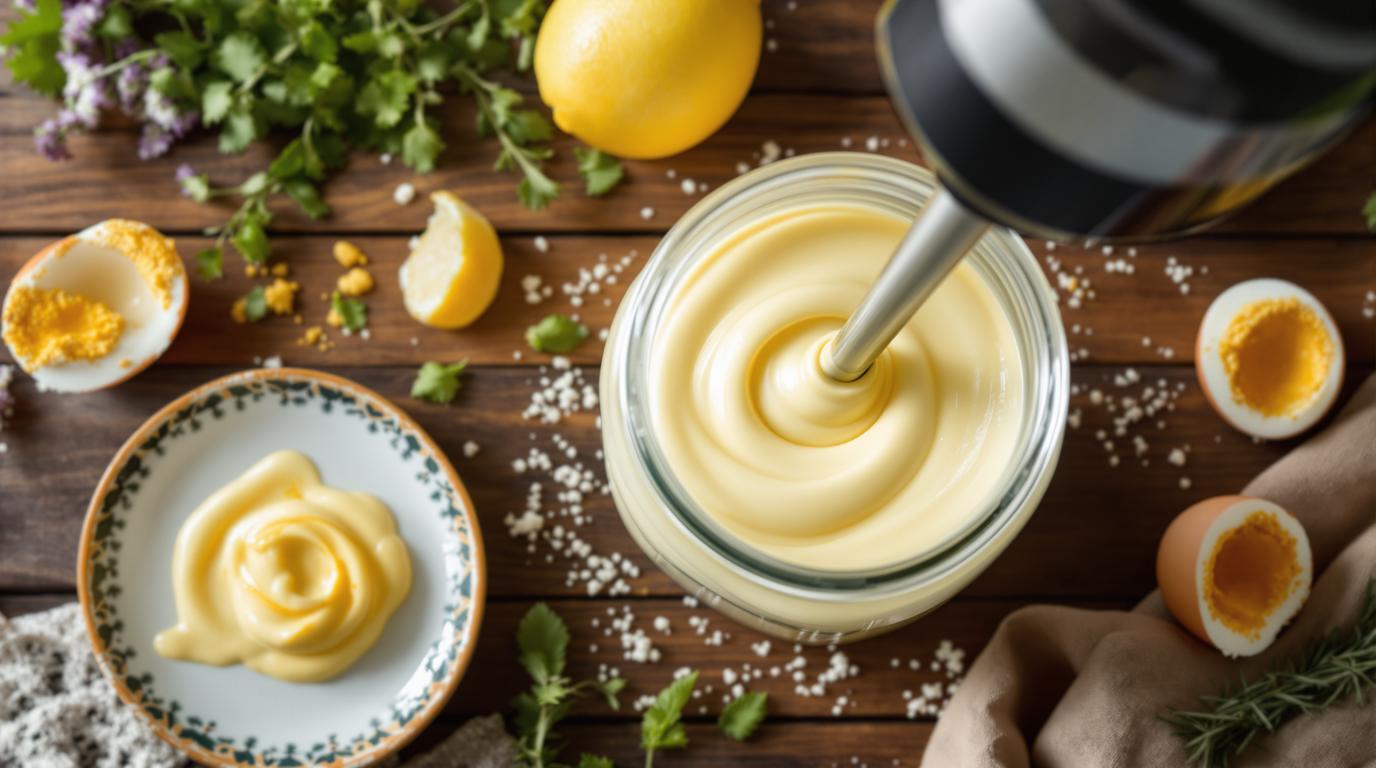There’s something magical about the transformation that happens when simple ingredients come together to create mayonnaise. In my grandmother’s kitchen, this was practically alchemy – watching her whisk oil drop by drop into egg yolks until a silky emulsion formed. It would take her nearly 15 minutes of careful attention and a steady hand. Today, I’ll show you how to achieve that same silky, rich mayonnaise in just 60 seconds using a stick blender – a method I discovered during my time in professional kitchens that honors tradition while embracing modern efficiency.
The 60-Second Traditional Mayonnaise
This mayonnaise recipe dates back generations, with roots in 18th-century French cuisine. What makes it special isn’t just the flavor – it’s the technique that transforms basic pantry ingredients into something extraordinary. My culinary school professor would be horrified at this shortcut, but the results are indistinguishable from the traditional arm-numbing method!
The secret lies in understanding the science of emulsification. When I was training in Paris, my mentor chef explained that mayonnaise is essentially a suspension of tiny oil droplets in water – and the stick blender creates the perfect environment for this magic to happen instantly.
Essential Ingredients
- 1 whole egg (room temperature)
- 1 tablespoon fresh lemon juice
- 1 teaspoon Dijon mustard
- ¼ teaspoon fine sea salt
- ¾ cup neutral oil (canola, sunflower, or light olive oil)
- Optional: pinch of white pepper or cayenne
Room temperature ingredients are absolutely crucial here. Cold eggs straight from the refrigerator are the main culprit behind broken mayonnaise. If you’re in a hurry, place your egg in warm (not hot) water for 5 minutes to take the chill off.
Step-by-Step Instructions
- Select a container that’s just slightly wider than your stick blender head – a mason jar or the beaker that came with your blender works perfectly.
- Add the egg, lemon juice, mustard, and salt to the bottom of your container.
- Pour the oil on top and let it settle for about 30 seconds.
- Place the stick blender head all the way to the bottom of the container, positioning it directly over the egg yolk.
- Without moving the blender, pulse for 5 seconds until you see the emulsion begin to form at the bottom.
- Very slowly raise the blender as the mayonnaise forms, taking about 20-30 seconds to reach the surface.
- Give one final blend across the top to ensure everything is incorporated.
Chef’s Secret Techniques
Chef’s Note: If your mayonnaise breaks or refuses to emulsify, don’t panic! Start with a fresh egg yolk in a clean bowl, then slowly drizzle in your broken mixture while blending. This rescue technique has saved countless batches in professional kitchens.
The most common mistake I see is moving the blender too quickly at the beginning. The magic happens when the blender creates a vortex that slowly pulls the oil into the egg mixture. If you’re struggling with homemade mayonnaise, try this foolproof blender trick that my grandmother swore by.
For a silky-smooth texture, try warming your mixing container by rinsing it with hot water and drying it thoroughly before adding ingredients. This slight temperature increase helps the emulsion form more readily – a trick I learned from an 80-year-old chef in Provence.
Flavor Variations
Once you’ve mastered the basic recipe, the variations are endless:
- Garlic Aioli: Add 2-3 garlic cloves
- Herb Mayo: Fold in 1 tablespoon each of finely chopped parsley, chives, and tarragon
- Spicy Mayo: Add ½ teaspoon sriracha or chipotle in adobo
- Lemon-Dill: Double the lemon juice and add 1 tablespoon fresh dill
Serving Suggestions
This mayonnaise elevates simple dishes to extraordinary heights. It’s perfect with crispy roast potatoes or as the base for potato salad. Use it to enhance a BLT sandwich or as a dipping sauce for artichokes. For the ultimate pairing, try it alongside soft-boiled eggs with a sprinkle of sea salt.
Homemade mayonnaise shines as the secret ingredient in deviled eggs or when used to bind homemade baked beans for a family gathering. It also makes a wonderful base for cold sauces like rouille to accompany fish dishes.
Storage and Shelf Life
Your mayonnaise will keep in an airtight container in the refrigerator for up to one week. Unlike commercial versions, there are no preservatives, so it won’t last as long – but the flavor is incomparable. I often use it as the base for quick pasta sauces by adding fresh herbs and a splash of homemade tomato sauce.
There’s something deeply satisfying about making staple ingredients from scratch. When you master this 60-second mayonnaise, you connect with generations of cooks who found joy in transforming humble ingredients into kitchen gold – just much faster than our grandmothers could have imagined. Happy cooking!
